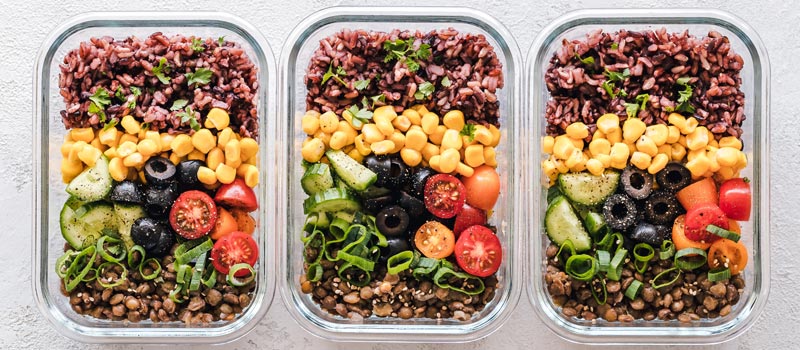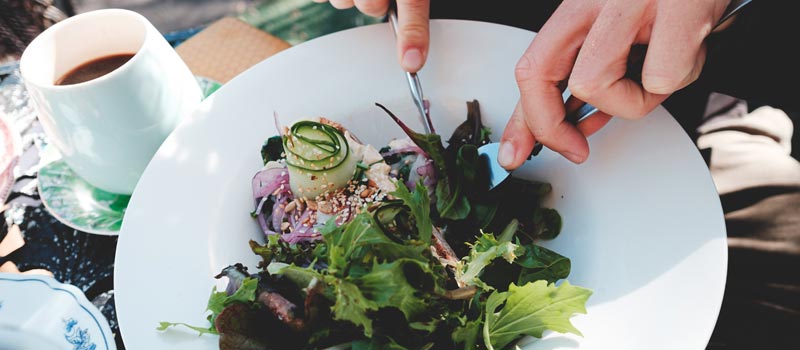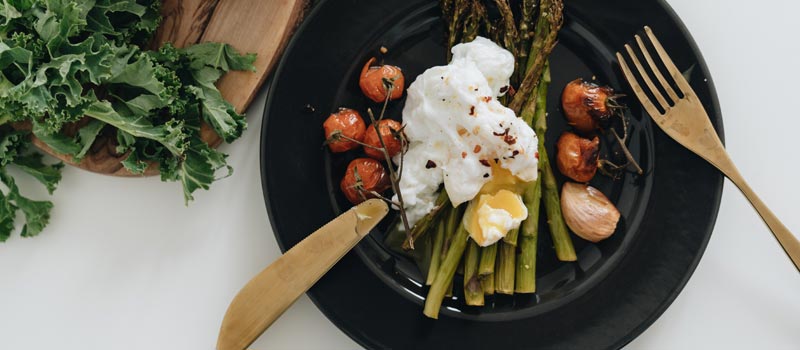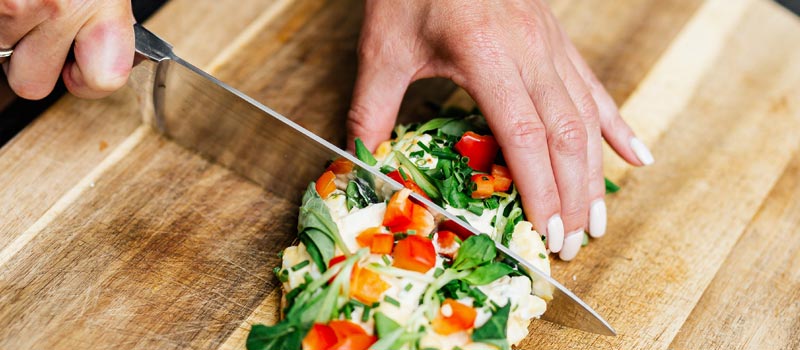Updated by J. Clifford and N. Mendez (4/23)*

Quick Facts…
- Cooking meals for one or two at home can be easy and enjoyable.
- Plan ahead and keep a variety of healthy foods on hand to prepare fresh meals and snacks.
- Build your meals by using the USDA website MyPlate.gov.
- Refrigerate leftovers within two hours of preparation
In recent years, eating alone has become as common as eating with friends and family, representing 46% of eating alone occasions. Potential explanations for this trend are busier lifestyles with demanding work schedules leaving no time or energy to cook or eat with others, as well as changes in family structures. As one person households are on the rise, there may be fewer opportunities for communal meals for people living alone or in smaller households.
For those who are more likely to eat alone (college students, older adults, or those with a busy school or work schedule) preparing a small meal may seem like a great deal of work.
Oftentimes recipes serve at least four, require a variety of ingredients, and leave leftovers that may be wasted. These problematic factors have led to the growing availability of fast foods, prepackaged meals, and in-between meal snacks, which are marketed as cheaper and faster options for busy individuals and families. However, these easy, quick, and sometimes highly processed meals are often less healthy due to high levels of sodium (salt), sugar, and fat.
Research also shows that for many, eating meals alone may lead to high calorie consumption. Older adults on the other hand, may have trouble consuming enough calories. These findings reinstate the importance of eating healthy balanced meals and nutrient dense snacks to maintain optimal health.
Preparing meals for one or two can be easy and enjoyable, by planning ahead and making meals simple. Additionally, many manufacturers now cater to the single diner with healthy pre-packaged individual serving foods to help create well balanced meals.

Planning Ahead
The easiest way to prepare a meal for one or two is to plan ahead. It is important to keep a variety of staple foods on hand in order to be prepared with all necessary ingredients when cooking a meal. Planning ahead also includes cooking meals that can be frozen and reheated later, when there is limited time to prepare an entire meal.
At the grocery store
Purchase dry items in bulk: Regularly consumed foods (such as cereal, oatmeal, rice, pasta, beans, and legumes) that are purchased in bulk, can be a cost-effective choice for many consumers. These dry food items can be easily divided into one or two servings.
Purchase fresh foods in small amounts: Foods such as dairy, fresh meat, and fresh fruits and vegetables should be purchased in small amounts so that the item can be consumed or frozen before it expires.
Purchase foods with a long shelf-life: Frozen meat, frozen or canned vegetables (low sodium), and frozen or dried fruits, are healthy examples of items with a long shelf-life.
Purchase single-servings: Individually wrapped items will extend the life of certain foods and allow for portability (examples include cheese, milk, yogurt, and fruit). Though these items might initially be more expensive compared to bulk items, greater savings will be seen in the long run due to less wasted food.
Keep frequently used ingredients on hand: Herbs, spices, sauces, and condiments, are important ingredients to keep in the kitchen that can be used in many recipes.
At home
Preserve foods by freezing, refrigerating, canning, or dehydrating: These methods are all effective at preserving foods, especially if an item cannot be eaten in a safe and reasonable amount of time.
Build your cookware collection: Have on hand a frying pan, or learn how to grill, broil, or roast different foods. These skills are valuable for making small meals with great flavor.
Plan leftovers accordingly: Plan leftovers so the only step is to simply reheat the food item.
Meals that make great leftovers include lasagna, enchiladas, or casserole, which can also be frozen for long periods of time.

Balancing Meals
Plan your meals to include all five food groups- fruits, vegetables, grains, protein foods, and dairy or fortified soy products. The USDA website, MyPlate.gov, serves as a useful guide for making daily food choices and building balanced meals. MyPlate recommends making half of one’s plate fruits and vegetables, and the other half grains (at least half should be whole grains) and protein (from varied sources), as well as adding fat-free or low-fat dairy on the side.
Using the framework for MyPlate, an example of a balanced meal containing all food groups could include a turkey sandwich with a slice of cheese, lettuce (or salad mix), and tomatoes, along with an apple. A few baby carrots or pre-packaged carrot sticks on the side will boost vegetable intake by adding additional vitamins, minerals, and fiber to the meal. Another example includes a plate of cooked pasta with spaghetti sauce, grated Parmesan cheese, and cooked lean ground beef. This meal, complemented with a side of canned peaches and steamed broccoli, has selections from each food group. Fresh tomatoes, onions, green peppers, or mushrooms can also be added to the sauce for more flavor and extra vegetables. A similar meal could be built using tortillas or rice in place of pasta, along with vegetables, fruits, and meat, beans or eggs with yogurt or a glass of milk.
See Table 1 for examples of meals that fit the USDA’s dietary guidelines for all five food groups.
Table 1. Sample daily meal plan that includes all five food groups.*
These meal suggestions also factor in healthy fats and low sodium options.
| Sample Meal | Fruit | Vegetable | Grains | Protein | Dairy | Healthy Fat | |
| Breakfast | Oatmeal with fruit and walnuts and one egg with bell pepper | Blueberries, raspberries, and/or blackberries | Bell pepper | Oatmeal | Walnuts, eggs | 6 ounce glass of non-fat milk | Walnuts, eggs |
| Lunch | Tuna Sandwich with toppings and side of cheese | Medium apple | Tomato, lettuce or salad mix. | Whole-grain bread | Tuna | Low-fat cheese | Lean fish |
| Dinner | Curried chicken with raisins and mushrooms and peppers | Raisins | Mushrooms, red bell pepper | Whole-grain bread | Boneless, skinless chicken | Fat-free milk | Olive oil |
Shelf LifeFoods that are canned, frozen, dried, or prepackaged, often have a longer shelf-life than fresh foods. When cooking for one or two, these products may be a cost-effective choice. However, it is important to examine the nutrition label closely and choose items with appropriate levels of sodium, sugar, fat, and overall calorie content. When purchasing canned or pre-packaged fruits, look for labels with 100% juice, and avoid added sugars. Before preparing canned vegetables, beans, or lentils, always rinse with water to lower salt content or choose those with “no salt added.” Whenever possible, select fresh, natural foods or items that are minimally processed. |
Eating Away from Home
Healthy Snacks
A busy lifestyle can often lead to the occasional skipped or shortened meal. In these cases, healthy in-between-meal snacks can play a very important role in providing valuable nutrients to help maintain a balanced diet. Snacks can be quick and easy to prepare and are a convenient option when eating away from home. Healthful snack ideas include cutup fruit with peanut butter, yogurt and berries, dried fruit, cut-up vegetables, whole-grain cereal, popcorn (low-salt and butter free), cheese, or lightly salted or unsalted mixed nuts.
Stick to whole, fresh foods, and avoid snacks that are processed or high in sodium, added sugar, or saturated fat (such as chips, cookies, or candy).

Eating Out
Eating meals away from home is a reality in today’s society, especially for those with busy schedules.
Healthy Tips for Eating Out:
- Be mindful of portion size. Many restaurants serve large portion sizes which may translate to more calories, sugar, and fat. The benefit from large portion sizes is that you can get two meals for the price of one. Divide the meal in half before eating and take the other half to-go or share.
- Limit condiment use—especially sauces and dressings. Request these items on the side.
- Choose foods that are grilled, broiled, or steamed, instead of fried.
- When given a choice of side dishes, choose fruits, vegetables, or low-fat dairy options, instead of fried foods or chips.
- Drink water, or low-fat dairy beverages instead of drinks with added sugar.
- Select dessert only sometimes. Share dessert with a friend, or order fruit instead.
- Order some carrot sticks and celery with ranch dressing and eat your veggies as an appetizer. While it might not be on the menu, most restaurants are happy to accommodate.

Reducing Recipes
| Table 2. Reducing Recipes* | |
| Half of a Recipe | |
| When the recipe calls for | To reduce, use |
| 1/4 cup | 2 tablespoons |
| 1/3 cup | 2 tablespoons + 2 teaspoons |
| 1/2 cup | 1/4 cup |
| 2/3 cup | 1/3 cup |
| 3/4 cup | 1/4 cup + 2 tablespoons |
| 1 tablespoon | 1 1/2 teaspoon |
| 1 teaspoon | 1/2 teaspoon |
| 1/2 teaspoon | 1/4 teaspoon |
| 9x2x13-inch pan | Square 8 x 2-inch or Round 9 x 2-inch |
| Third of a Recipe | |
| 1/4 cup | 1 tablespoon + 1 teaspoon |
| 1/3 cup | 1 tablespoon + 2 1/3 teaspoons |
| 1/2 cup | 2 tablespoons + 2 teaspoons |
| *Cooking times, temperature, pan size, and seasonings may vary when certain recipes are scaled. Closely monitor the food to determine whether any alterations are necessary | |

Most recipes have the potential to be cut in half or in thirds. Some ingredients, like an egg for example, are difficult to divide. If the recipe calls for a large egg, try using a small egg or just the egg white to cut the recipe in half. In some cases, it may be easier to make the entire recipe and freeze the rest for later. For easy references, see Table 2.
Store Food Safely
All uneaten food should be stored safely and properly. Store leftovers into thick plastic bags or shallow plastic or glass containers. Leftovers should be refrigerated or frozen within two hours. Label and date by using tape or an erasable marker. Most frozen foods will last 3 to 6 months. When re-heating your meals in the microwave, use microwave safe containers.
Make Mealtime Enjoyable
Create a pleasant setting for dining at home by listening to relaxing music, turning off the television or other electronic devices, choosing a pleasant location (e.g., outside), or setting the table with flowers and candles. Invite friends or family over for meals or host a potluck dinner.
Summary
Whether you are preparing one or two servings of a home-cooked dinner meal, planning ahead for tomorrow’s lunch at work, or deciding which restaurant to dine at, use these tips to help make meal planning easy and convenient. Table 3 describes some staple items to consider keeping in your kitchen. Healthy eating may reduce your risk of certain health problems, like type 2 diabetes, obesity, heart disease, and cancer. A good diet gives you the energy and nutrients you need to stay healthy. Make healthy eating easy and fun when you’re eating alone by creating a colorful plate of food.
| Table 3. Examples of suggested items to keep onhand in the kitchen | |
| Cookware | Cutting board, chef knife, frying pan, casserole dish, medium pots, mixing bowls, loaf pan, measuring cups and spoons, strainer, spatula, and can-opener |
| Appliances | Toaster oven, crockpot, blender, rice cooker, microwave |
| Staple Food Items (long shelf-life, shop for infrequently) | Whole-grains (rice, pasta, couscous, quinoa, oatmeal, cereal), dried or canned beans and lentils, canned vegetables (low sodium), nuts, dried fruit, nut butter (peanut, almond, sunflower), olive oil, herbs, and spices |
| Perishable Food Items (short shelf-life, shop for frequently) | Eggs, low-fat or fat-free dairy, fresh fruits and vegetables, and proteins such as meat, poultry, and fish |
| Food Storage | Food storage containers, aluminum foil, plastic wrap, and plastic bags |
References
Duyff, R. L. (2006). American Dietetic Association: Complete Food and Nutrition Guide. Hoboken: John Wiley & Sons, Inc.
Marquis, M. (2005). Exploring convenience orientation as a food motivation for college students living in residence halls. International Journal of Consumer Studies, 29: 55-63.
U.S. Census Bureau. (2019). One-Person Households are on the Rise. Last assessed on March 27, 2023.
USDA Food and Nutrition Service. (2022). Meal Planning. USDA. Last assessed on March 27, 2023.
*J. Clifford, Colorado State University Extension Nutrition Specialist and Registered Dietitian and N. Mendez, Colorado State University Graduate Student. Previously revised by L. Bellows, Colorado State University Extension Nutrition Specialist and Assistant Professor; R. Moore, Graduate Student; A. Gross, Undergraduate Student. 10/13.
Go to top of this page.





